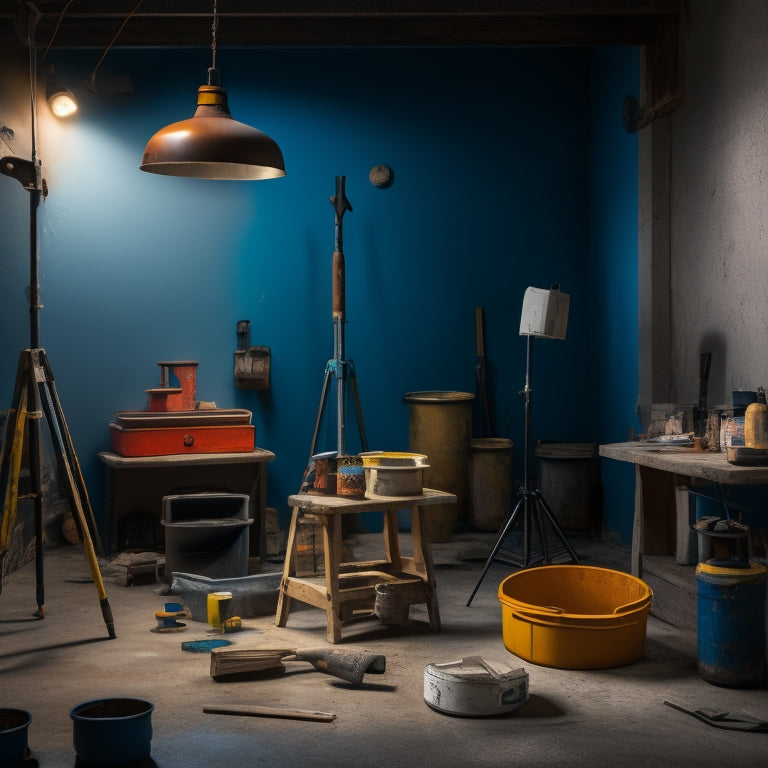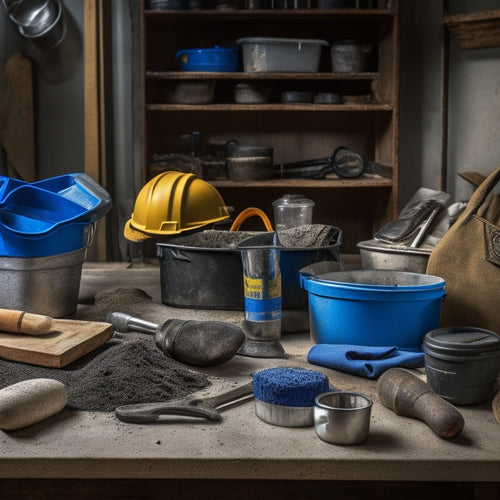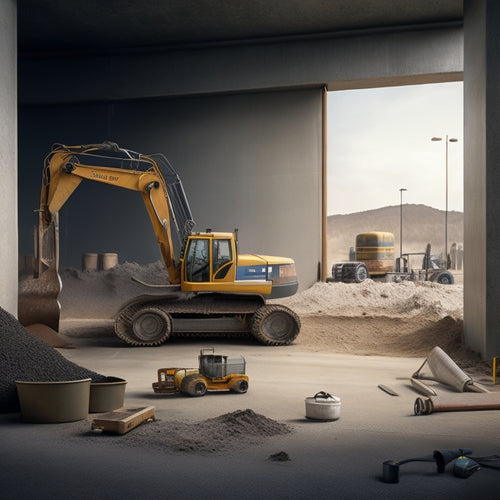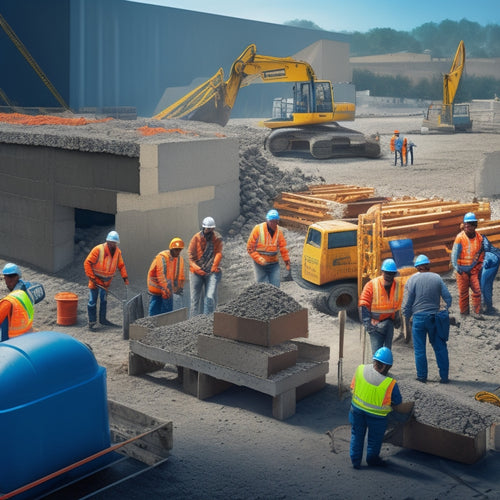
Best Tools for Painting Concrete Blocks
Share
When painting concrete blocks, you'll need a range of high-quality tools to achieve a smooth, professional-looking finish. Invest in various-sized, angled sash brushes for corners and edges, flat brushes for larger areas, and block pattern brushes for textured blocks. Microfiber or wool roller sleeves, depending on the surface, are essential for efficient painting. Extension poles, surface preparation power tools like angle grinders, and masking tools like painter's tape and liquid maskant will also come in handy. By mastering the use of these specialized tools and techniques, you'll be well on your way to achieving a flawless finish that showcases your skill.
Key Takeaways
• High-quality brushes in various sizes and shapes are essential for achieving a smooth finish on concrete blocks.
• Microfiber and wool roller sleeves are suitable for smooth and rough surfaces, respectively, and require gentle, even strokes with moderate pressure.
• Extension poles made of fiberglass, aluminum, or carbon fiber provide durability and control when painting high concrete block areas.
• Surface preparation power tools like high-torque angle grinders and rotary hammer drills remove dirt and old coatings, ensuring a uniform coat.
• Painter's tape designed for concrete, masking film, and liquid maskant help create crisp edges and sealed barriers for professional-looking results.
Essential Brushes for Smooth Finish
You'll need a range of high-quality brushes in various sizes and shapes to obtain a smooth, even finish when painting concrete blocks.
For corners and edges, use angled sash brushes, which allow for precise control and maneuverability. For larger, flat areas, opt for flat brushes with stiffer bristles to guarantee a uniform coat. Natural bristle brushes are ideal for oil-based paints, while synthetic brushes work best with water-based paints.
When it comes to finish techniques, you'll want to master the 'W' and 'M' patterns to prevent streaks and marks. Start with a light, even coat, then build up to the desired color intensity.
For a textured finish, use a stiff-bristled brush to create a subtle, raised pattern. For a smooth finish, switch to a softer-bristled brush and work in small, circular motions.
Rollers and Extensions for Large Areas
When painting large areas of concrete blocks, you'll need to choose the right roller sleeve options to guarantee a uniform finish.
You'll also want to take into account extension pole lengths that allow you to reach high areas comfortably, without sacrificing control.
Roller Sleeve Options
Painting large areas of concrete blocks efficiently requires selecting the right roller sleeve options, which include specialized rollers and extensions designed to cover extensive surfaces with ease.
As you prepare to tackle your concrete block painting project, you'll need to take into account the type of roller sleeve materials that will work best for your specific needs. Microfiber roller sleeves, for instance, are ideal for smooth surfaces and provide a lint-free finish. On the other hand, wool roller sleeves are better suited for rough surfaces and offer superior paint pickup.
When it comes to roller sleeve sizes, you'll want to choose the right diameter and nap length to guarantee even paint distribution. A larger roller sleeve diameter (18-24 inches) will cover more surface area, while a shorter nap length (1/4-1/2 inch) is better for smooth surfaces.
Remember to select a roller sleeve that's compatible with your extension pole and can hold a sufficient amount of paint. By making the right roller sleeve choice, you'll be able to complete your project efficiently and achieve a professional-looking finish.
Extension Pole Lengths
With your roller sleeve selection in hand, it's time to focus on the extension pole length that will enable you to cover large areas of concrete blocks without straining or sacrificing paint quality. The right extension pole length will give you the freedom to paint with ease and efficiency.
When choosing an extension pole, evaluate the height of the area you need to paint and the type of paint you're using. A longer extension pole will allow you to reach higher areas, while a shorter pole is better suited for smaller areas or thicker paints.
Here are some common extension pole lengths and materials to evaluate:
| Extension Pole Length | Materials |
|---|---|
| 4-6 ft | Fiberglass, Aluminum |
| 6-8 ft | Fiberglass, Aluminum, Carbon Fiber |
| 8-10 ft | Fiberglass, Aluminum |
| 10-12 ft | Carbon Fiber, Fiberglass |
| 12-15 ft | Carbon Fiber |
Top extension pole brands include Purdy, Wooster, and Zinsser. Look for poles made from durable materials like fiberglass, aluminum, or carbon fiber, which can withstand heavy use and support the weight of your roller. By selecting the right extension pole length and material, you'll be able to paint large areas of concrete blocks with ease and precision.
Masking Tools for Crisp Edges
You'll need to invest in high-quality masking tools to achieve crisp, sharp edges on your concrete block painting project. When it comes to tape application, you can't afford to skimp on quality. Look for painter's tape specifically designed for concrete, as it will provide better adhesion and edge control.
Apply the tape carefully, making sure it's pressed firmly onto the surface to prevent paint seepage. For complex edges, consider using a masking film or liquid maskant to create a sealed barrier. These tools will give you the precision you need to accomplish sharp, clean lines.
For added edge control, use a putty knife or credit card to press the tape firmly onto the concrete. This will guarantee a tight seal and prevent paint from bleeding underneath.
Remember to remove the tape slowly and carefully after painting to avoid pulling off the fresh paint. With the right masking tools and a bit of patience, you'll be able to achieve professional-looking results with crisp, sharp edges that will make your concrete block project stand out.
Surface Preparation Power Tools
Before applying paint, utilize a high-torque angle grinder or a rotary hammer drill to aggressively remove dirt, grime, and old coatings from the concrete block surface, guaranteeing a strong bond between the paint and the substrate.
Next, switch to sanding techniques to smooth out the surface. You have several power sander options to choose from, each suited for specific tasks. For example:
| Sander Type | Best For |
|---|---|
| Belt sander | Removing old coatings and rough surfaces |
| Orbital sander | Smoothing out surfaces and feathering edges |
| Angle grinder with sanding disc | Aggressive material removal and shaping |
| Random orbital sander | Fine sanding and polishing |
When selecting a power sander, consider the surface condition, the desired finish, and the level of aggression required. Always work progressively through grits, starting with coarse and moving to fine, to achieve the best results. Remember to wear protective gear, including gloves, safety glasses, and a dust mask, to guarantee your safety during the sanding process.
Specialty Brushes for Textured Blocks
When painting textured concrete blocks, you'll need specialized brushes that can navigate the unique surfaces.
You'll want to reach for block pattern brushes, designed to fit snugly into the block's recesses, or rough surface rollers that can tackle heavily textured areas.
Additionally, angular edge tools will help you cut in around corners and edges with precision.
Block Pattern Brushes
With textured blocks requiring a more nuanced approach, block pattern brushes are specifically designed to tackle the unique challenges of painting these surfaces.
These brushes feature specially designed bristles that conform to the block's texture, allowing you to achieve a smooth, even coat of paint. When it comes to block painting techniques, block pattern brushes are essential for creating creative patterns on textured blocks. They enable you to work with precision, ensuring that your design is executed flawlessly.
When choosing a block pattern brush, consider the type of texture you're working with. For example, if you're painting a block with a rough, porous surface, you'll want a brush with stiffer bristles to reach into the crevices. For smoother textures, a softer-bristled brush will provide a more even finish.
Rough Surface Rollers
You'll find that rough surface rollers, also known as specialty brushes for textured blocks, are designed to tackle the most challenging surfaces, effortlessly maneuvering through deep crevices and irregularities to deliver a uniform coat of paint. These rollers are engineered to navigate the unique topography of concrete blocks, guaranteeing a professional-looking finish.
To get the most out of your rough surface rollers, follow these best practices:
-
Choose the right nap length: Select a roller with a nap length that matches the texture of your concrete block. This guarantees ideal paint pickup and release.
-
Master your application techniques: Use gentle, even strokes to maintain consistent coverage. Apply moderate pressure, increasing as needed for stubborn areas.
-
Prioritize roller maintenance: Regularly clean and inspect your rollers to prevent paint buildup and damage. This extends their lifespan and assures a smooth, even finish.
Angular Edge Tools
Painting concrete blocks often requires maneuvering sharp corners and edges, which is where angular edge tools, also known as specialty brushes for textured blocks, come into play. These tools expertly reach into tight spaces and crevices to guarantee a seamless finish. You'll find that they are specifically designed to tackle the unique challenges of painting textured blocks, allowing you to work efficiently and effectively.
When choosing an angular edge tool, consider the type of block you're working with and the level of texture it has. This will help you select the right angular edge materials for the job. For example, if you're working with highly textured blocks, you may want to opt for a brush with stiffer bristles to ascertain adequate coverage.
Mastering angular edge techniques takes practice, but with the right tools and a bit of patience, you'll be able to achieve professional-looking results. Remember to work slowly and deliberately, using gentle strokes to cover the entire surface of the block. By doing so, you'll be able to achieve a flawless finish that showcases your skills and attention to detail.
Safety Gear for Protective Painting
Protect your skin, eyes, and respiratory system from harsh chemicals and airborne particles by wearing the essential safety gear during concrete block painting. As you prepare to tackle your project, remember that safety precautions are just as important as the right tools and techniques. Without proper protective clothing, you're putting yourself at risk of injury or illness.
Here are the top three must-haves for safety gear:
-
Respirator Mask: A high-quality respirator mask will filter out airborne particles and chemicals, ensuring you can breathe easily and safely.
-
Gloves and Protective Clothing: Wear gloves, long sleeves, and pants to prevent skin contact with harsh chemicals and paint. Look for clothing with built-in protection, such as waterproof and breathable materials.
-
Safety Goggles: Protect your eyes from splashes and spills with safety goggles that provide 360-degree protection.
Frequently Asked Questions
Can I Use Regular Latex Paint on Concrete Blocks?
You're wondering if you can use regular latex paint on concrete blocks. The short answer is, it's not the best choice.
Latex paint won't adhere well to concrete block textures, resulting in a weak bond and potential peeling.
Instead, consider latex paint alternatives specifically designed for concrete, such as epoxy-based or acrylic coatings.
These paints will provide a strong, durable finish that'll withstand the elements and give you the freedom to enjoy your newly painted concrete blocks.
How Do I Remove Old Paint From Concrete Blocks?
Imagine scrubbing away at a stubborn stain on your favorite shirt - that's what removing old paint from concrete blocks can feel like!
To free yourself from this frustration, start by using paint removal techniques like power washing or chemical stripping to break down the old paint.
Next, prepare the concrete block surface by scrubbing it with a wire brush to remove any remaining paint residue and roughen the surface for new paint to adhere.
Do I Need to Prime Concrete Blocks Before Painting?
You're wondering if priming concrete blocks is necessary before painting. The answer is yes, and it's essential for ideal paint adhesion.
Without priming, paint may peel or flake off due to the block's porous nature. By using the right priming techniques, you'll create a strong bond between the paint and concrete, ensuring a durable, long-lasting finish.
Take the time to prime, and you'll enjoy a beautiful, liberated look that lasts.
Can I Paint Concrete Blocks in Cold Weather?
When you're planning to paint concrete blocks, you need to take into account the cold weather implications.
Painting in cold weather can lead to paint adhesion issues, which can compromise the entire project. You'll want to make certain the temperature is above 50°F (10°C) and the blocks are dry and free of moisture.
If you can't wait for warmer weather, use a specialized cold-weather paint or primer to mitigate the risks.
How Long Does It Take for Concrete Block Paint to Dry?
You're probably aware that the fastest-drying paint on the market can dry in as little as 10 minutes!
When it comes to concrete block paint, the drying time varies depending on the paint type. Acrylic and latex paints usually take 1-2 hours to dry to the touch, while epoxy and urethane-based paints can take 2-4 hours.
Make sure to follow the manufacturer's instructions for best results.
Conclusion
You've got the perfect tools for painting concrete blocks, and now it's time to get to work.
With the right brushes, rollers, and surface preparation power tools, you'll achieve a professional-looking finish.
Did you know that according to the American Coatings Association, the global paints and coatings market is projected to reach $143.6 billion by 2025?
This growing demand highlights the importance of using high-quality tools to deliver exceptional results.
Get painting and take part in this booming industry!
Related Posts
-

5 Tools Needed for Quick Fix Concrete Mixing
You'll need five essential tools to tackle a quick fix concrete mixing project efficiently. First, you'll require a s...
-

Why You Need Affordable Concrete Wall Construction Tools
You need affordable concrete wall construction tools to guarantee a profitable project, as the cost of equipment can ...
-

7 Best Tools for Concrete Block Construction
You'll need a solid foundation, precise cutting, and seamless finishing to guarantee your concrete block construction...


